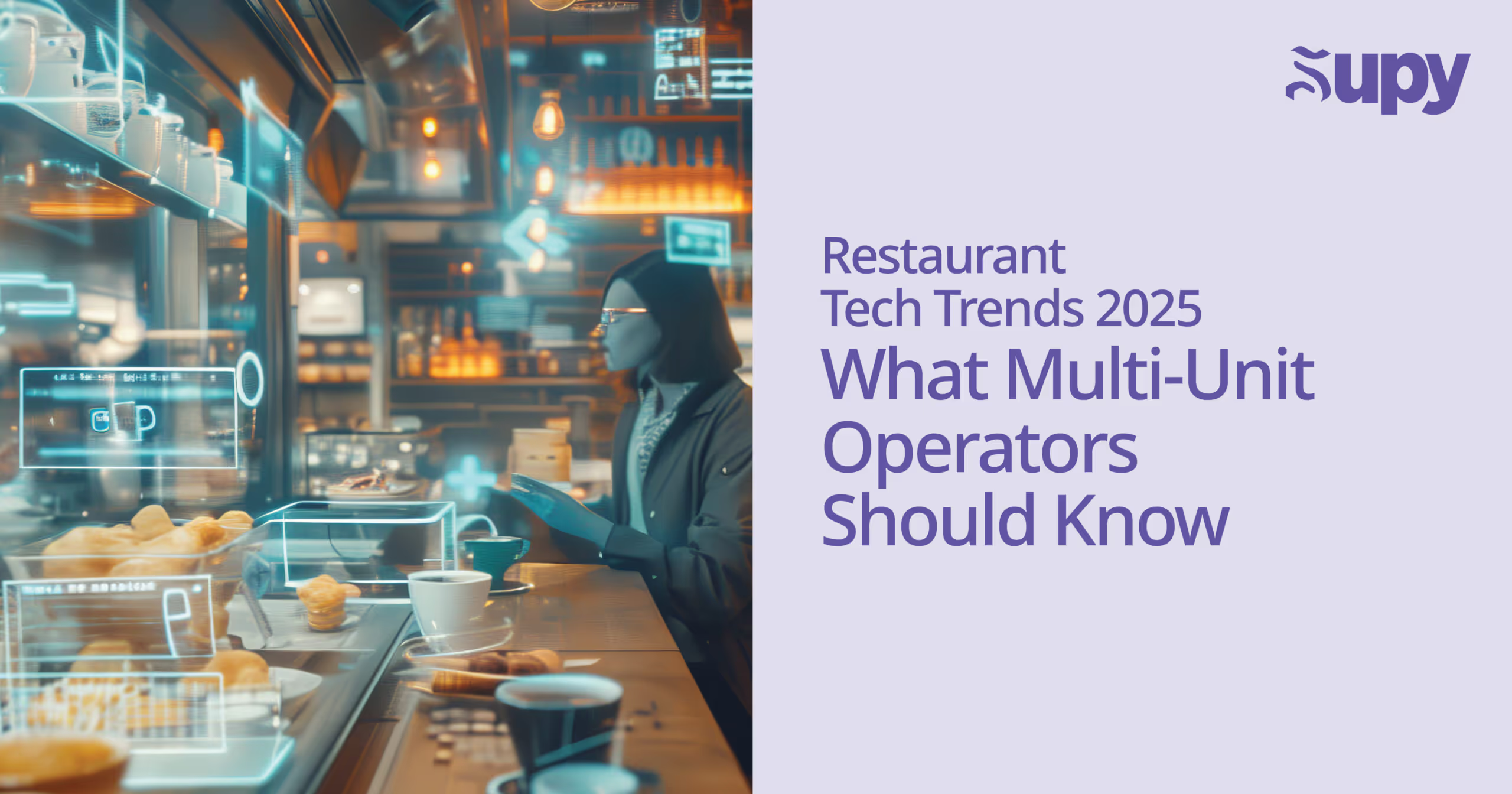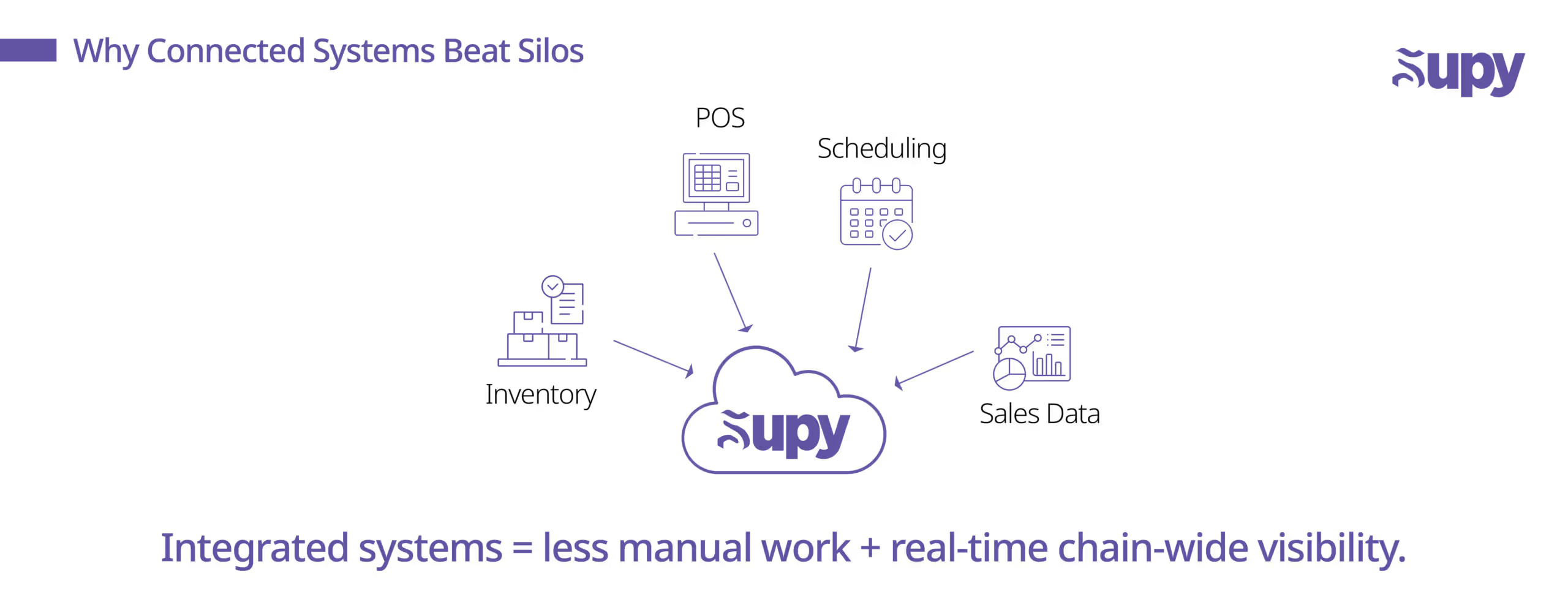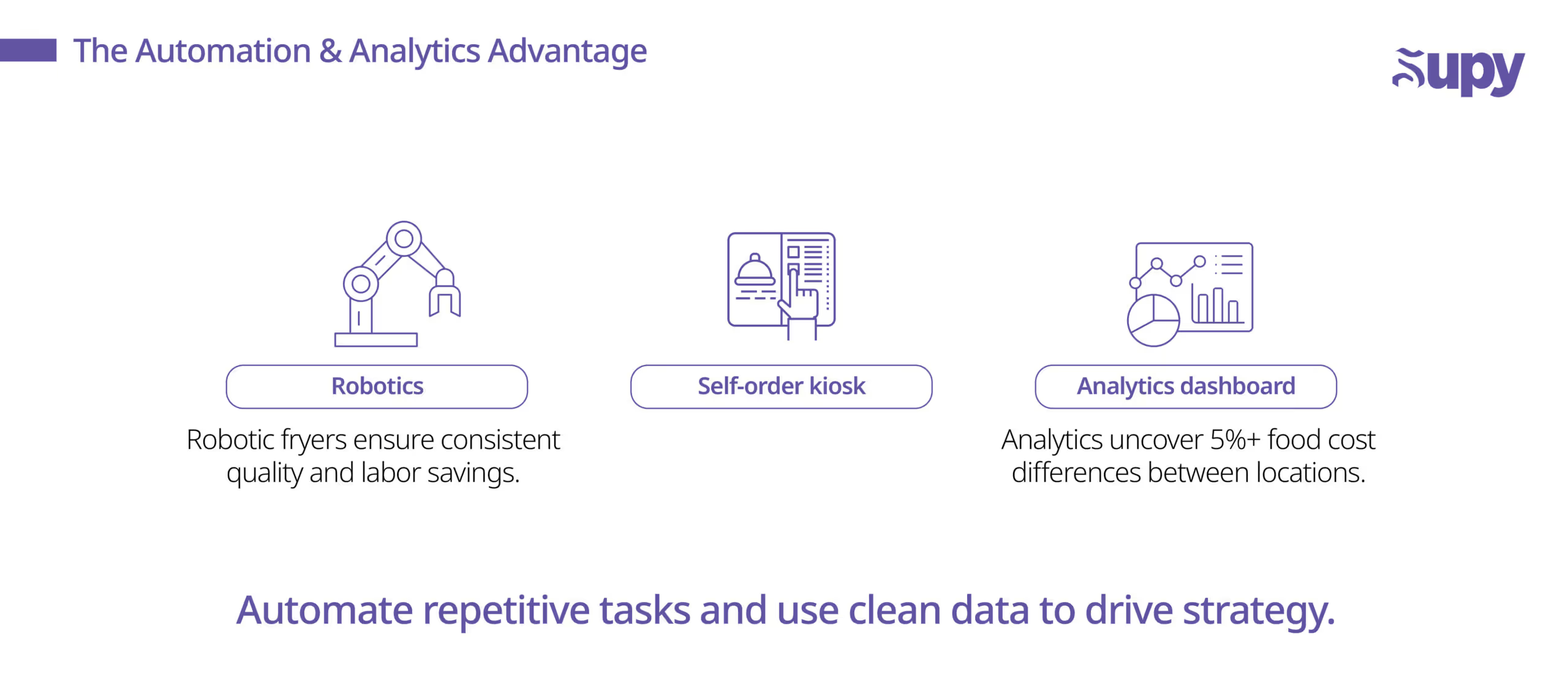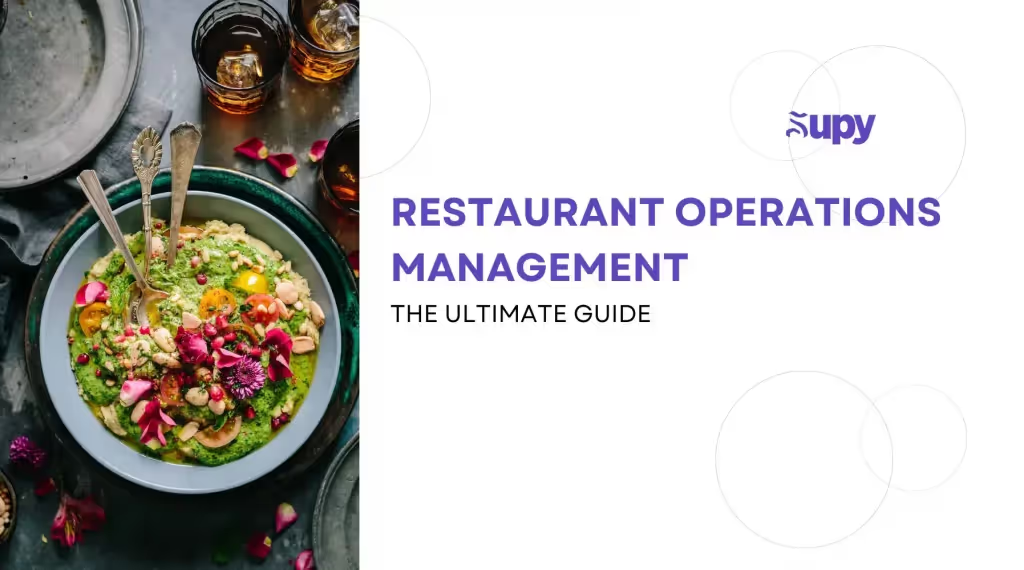Restaurant Tech Trends 2025: What Multi-Unit Operators Should Know

The restaurant industry is undergoing a tech revolution, and multi-unit operators stand to gain the most from it. In 2025, technology isn’t just a nice-to-have – it’s central to running efficient, scalable operations. A recent report noted that 76% of restaurant operators believe tech gives them a competitive advantage , yet only 13% are fully satisfied with their current tech stack. This gap means there’s big opportunity to improve. From AI-driven analytics to kitchen automation, new solutions are emerging to help restaurants cut costs, enhance the guest experience, and make better decisions across all their locations.
For operators of 10, 20, or 100 restaurant units, leveraging these tech trends can unlock consistency and savings at scale. Below, we outline the top restaurant technology trends of 2025 that multi-unit restaurant leaders should have on their radar, along with practical ways to capitalize on them.
1. Smarter Inventory Management with AI and IoT

Inventory management is becoming highly automated and data-driven. Modern inventory systems now use artificial intelligence (AI) to forecast demand more accurately than ever. By analyzing historical sales, seasonal patterns, and even variables like weather or local events, AI tools can predict exactly how much of each ingredient you’ll need for each location – reducing stockouts and cutting waste from over-ordering. According to McKinsey, AI-based forecasting can reduce inventory errors by up to 20–50%.
In 2025, more restaurant groups are also experimenting with IoT sensors and smart devices in the kitchen. For example, internet-connected temperature sensors in fridges can send instant alerts if a cooler goes down, saving thousands in spoiled inventory. Smart scales can automatically log usage of key ingredients. These technologies ensure that what’s happening on the ground (a freezer door left open, a keg running low) is immediately captured and communicated to managers.
Multi-unit operators should pilot these tools in a few locations: connect your POS and inventory software to enable AI-driven ordering recommendations, or install IoT monitors for critical storage areas. The ROI can be significant – one early adopter chain cut food waste by 15% after implementing an AI-powered inventory system that optimized their ordering and detected anomalies.
2. Unified Systems and POS Integration

Gone are the days of each restaurant system operating in a silo. In 2025, the trend is integrated, cloud- based platforms that tie together POS, inventory, online ordering, labor scheduling, and more. Over half of enterprise restaurant businesses (52%) have already moved to cloud-based POS platforms as of this year, and independents are following suit.
When your POS “talks to” your inventory management and purchasing system, magical things happen: every sale automatically decrements inventory, so you’re not stuck guessing what’s in stock or fixing mistakes at the end of the night. Your accounting gets automated because purchase orders and invoices flow through to the books. An integrated setup also means multi-unit dashboards – you can log into one system and see sales, labor, and inventory data for all locations in real time.
For operators, investing in unified systems yields better data and less manual work. If you’re still using separate POS, spreadsheets, and standalone apps that don’t sync, consider upgrading to a platform or an integration middleware that links them. It will improve accuracy (no more forgetting to key in an invoice) and speed up workflows from ordering to reporting.
3. Digital Ordering and Delivery Innovations

The pandemic permanently accelerated the shift to online ordering and delivery. Going into 2025, restaurants are refining their digital channels with new tech: - Direct online ordering platforms: Instead of relying solely on third-party apps (and paying high commissions), many restaurants are beefing up their own websites/apps for takeout and delivery. These platforms integrate with POS and send orders straight to the kitchen. They also capture valuable customer data. Restaurants with robust direct ordering are seeing takeout profit improvements of up to 30% higher than those only using third-party services. - Mobile order and pay at table: Especially in fast-casual and casual dining, giving guests the ability to order or pay from their phone at the table is gaining popularity. This tech speeds up service and can boost table turns without adding staff. - Virtual brands and ghost kitchens: Multi-unit operators are using their existing kitchens to host additional “virtual” restaurant brands that exist only on delivery apps. Tech platforms make it easier to manage multiple brand menus and routes orders appropriately. This trend leverages excess kitchen capacity to increase revenue. - Delivery optimization: Tools for managing delivery drivers or integrating with multiple delivery services help streamline off-premise operations. Some chains are even testing drones and robots for delivery, though those are still experimental.
For multi-location restaurants, the key is ensuring consistent digital presence and efficiency. Evaluate your online ordering experience – is it user-friendly and integrated? If you have many locations, consider a unified loyalty app or ordering platform to centralize customer engagement. In 2025, the easier you make it for guests to order from you digitally, the more sales you’ll capture.
4. Automation in Kitchens and Service

Labor shortages and cost pressures have fueled a boom in automation solutions for restaurants. We’re seeing robots flipping burgers and frying chicken, automated espresso machines and cocktail stations, and even AI-driven kitchen assistants that can visually monitor food quality. While full “robot-run” restaurants are not common yet, targeted automation of repetitive tasks is rising.
For example, some quick-service brands use automated fryers that lift baskets at precisely the right time – ensuring consistency and reducing labor need at the fryer station. Others have installed self-order kiosks, reducing the strain on cashiers and improving order accuracy. Robotic kitchen equipment can increase throughput and reduce waste by cooking exactly to spec every time.
Front-of-house is also feeling the automation wave with things like QR code ordering, pay-at-table devices, and even robot servers in some cases. These technologies don’t replace staff so much as augment them – allowing fewer people to serve more guests efficiently (a big win for multi-unit operators facing high labor costs).
If you operate 10+ units, even small automations can add up. Consider testing one in each area: maybe a robotic prep tool (like an automatic vegetable chopper) in the kitchen, a self-order kiosk at the front, or a table-top payment system in one section. Track the impact on speed, labor hours, and guest feedback. Many early adopters report that the consistency alone (e.g., every burger patty cooked exactly the same) saves on food cost and improves customer satisfaction.
5. Data Analytics and Clean Data Focus
With so many digital systems, restaurants are swimming in data – the next trend is making that data actionable. Business intelligence (BI) and analytics tools tailored for restaurants are helping multi-unit operators identify opportunities and inefficiencies at a glance. For instance, a dashboard might show that one location has a 5% higher food cost than the others – prompting a deeper look into waste or theft there. Or analytics may reveal that certain menu items drive higher repeat orders, informing your marketing focus.
However, good analytics require clean, consistent data from each store. That’s why many chains in 2025 are emphasizing data integrity: standardizing how items are named in the system, ensuring every branch follows the same procedures for entering sales, invoices, waste, etc. Inconsistent data entry can lead to garbage-in, garbage-out when you run reports. As one Supy blog noted, without a unified system, you risk inconsistent inventory management and poor decision-making.
The trend here is both cultural and technological: building a data-driven culture where managers trust and use the reports, and investing in tools (or even hiring analysts) to crunch the numbers. Multi-unit groups are hiring data analysts or using advanced reporting software to sift through POS and inventory data for insights – like identifying the 10 menu items that contribute 70% of food cost variance, or predicting which store will have the highest turnover risk this quarter. The bottom line is, treating your data as a strategic asset will set you apart. Those who do are finding they can lower costs and increase revenue by acting on insights that were previously buried in spreadsheets.
The technology landscape in hospitality is evolving fast. Multi-unit restaurant leaders who embrace these trends – from AI-driven inventory and integrated systems to kitchen automation and analytics – will outpace the competition in efficiency and guest satisfaction. If you’re ready to upgrade your tech stack, start with the backbone of your operations: inventory and supply chain management. Get a firsthand look at how Supy’s data-driven platform can cut waste and save time by booking a demo. And be sure to read our blog “Must-Have Restaurant Technologies for 2025” for more ideas on staying ahead of the curve.
Related Resources
- Podcast: Supply Chain Director : This Is What Builds Profitable Businesses (Tashas Group)
- 10 Tips To Reduce Restaurant Food Waste
- The Ultimate Guide To Restaurant Operations Management
Take your hospitality business
to the next level
FAQ
What’s the benefit of using AI in restaurant operations?
AI can analyze huge amounts of data to find patterns humans might miss. In practice, this means more accurate sales and demand forecasts, smarter scheduling, and optimized inventory orders. The benefit is lower costs (through reduced waste and better staffing) and higher revenue (through improved menu mix and marketing). A 2024 study found many restaurants saw efficiency gains after implementing AI tools, with forecasting errors dropping significantly.
Is investing in tech worth it for smaller restaurant chains (10–15 units)?
It can be, yes. The right tech can quickly pay for itself. For example, an inventory system that reduces waste by just 2% or a scheduling tool that cuts overtime could save a small chain tens of thousands annually. The key is to choose technology that addresses your biggest pain points (inventory, labor, etc.) rather than adopting tech for tech’s sake. Start with one system, measure the results, and expand from there.
How do I get my staff to adopt new technology?
Change management is crucial. Involve your team early – explain the “why” (e.g., “This new system will make ordering trucks easier and prevent running out of ingredients”). Provide ample training and choose user-friendly tools. Designate tech “champions” at each location to help their peers. Also, roll out one change at a time; don’t overwhelm staff with five new apps overnight. When employees see that the tech actually makes their jobs smoother (not harder), adoption will follow.
What about data security and privacy with all these tech systems?
This is an important consideration. Work with reputable vendors who follow data security best practices (encryption, secure data storage, etc.). Limit access to sensitive data – for instance, your managers might need detailed sales and inventory data, but perhaps not every staff member should see those. Also, ensure you’re complying with any customer data privacy laws (like not spamming customers without consent). Reputable restaurant tech providers will outline how they protect your data. Always ask if you’re unsure – protecting customer and business data is part of staying ahead in tech.
What emerging tech on the horizon could be big in the next few years?
Keep an eye on voice technology and AI assistants (like voice ordering through Alexa or Google), automated drive-thrus using AI voice bots, and continued advances in kitchen robotics. Some predict that within a few years, AI could handle tasks like dynamic pricing (adjusting menu item prices based on demand, like airlines do). Also, as sustainability becomes a focus, tech that helps reduce waste (like smart composting or upcycling systems) might become mainstream. The restaurant of 2030 will likely be even more tech-enabled – but the core goal will be the same: improving guest experience and operational efficiency.







